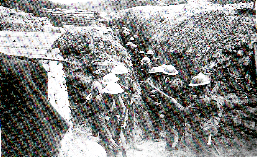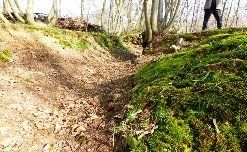Norsey Wood's First World War Training Trenches



To find the trenches, walk down the main path from the car park until you come to an open area on the right. Follow the path opposite this area, then turn left at the barrier ahead. Continue along this path until you reach a turning on the right lined with small logs. Keep an eye to the left and you should eventually see a small clearing with a brushwood barrier beyond. Please do not climb down into the trench as the edge and sides are fragile.
As a part of Billericay's commemoration of the outbreak of WW1 in 1914, a part of the training trenches in Norsey Wood has been cleared of a hundred years’ accumulation of leaves and fallen timber. This part, which you can view from the fence in front of you, is probably the best preserved section of trenches which stretch for a total of about 750 metres from Norsey Road in the NW to Outwood Common Road in the SE.
You will notice that the far side is higher than where you are standing. This probably indicates that that is the back of the trench. Soldiers on watch would have stood on a ledge above the bottom of the side nearest you, so that they could see the enemy.
This would have made them partly visible to the enemy and vulnerable, so the bank behind, being higher, would help to make them less easily seen by preventing a silhouette.
The ground where you are standing slopes gently away from the edge of the trench and forms a protective barrier to incoming fire. This is known as a parapet. The rear, higher bank is called a parados.
The cuts in the far side are L-shaped and may have been used by off-duty soldiers for resting. Here they are about 10 metres apart and are probably closer than they would have been on the Western Front, as the different groups of soldiers coming to Billericay would have needed training in actually digging as well as using trenches.

The section here which stretches about 350 metres to the right is in a wavy design, whereas the section that continues beyond the main path to the left is a Greek key design.
Trenches were never dug in a straight line as this would have put many more soldiers in danger if the enemy had entered the trench and fired along it. Also if a device had fallen in or nearby and exploded, the effect would kill or injure many more.
Please do not enter the trenches and keep back from the edge, as the sides are very fragile and break easily. Thank you!
